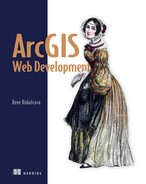Table of Contents
1. ArcGIS JavaScript Foundation
1.1. GIS: here, there, everywhere
1.1.1. The GIS tools landscape
1.1.2. Introducing the ArcGIS platform
1.2. Understanding the GIS bits
1.2.1. The what and the where of GIS data
1.3.1. JavaScript, Dojo Toolkit, and Dijit
Chapter 2. Introducing core API concepts
2.2. Understanding layers and accessing data
2.2.1. Layer types for raster-based data
2.2.2. Layer types for vector-based data
2.3. Working with the FeatureLayer
2.3.1. Advantages of a FeatureLayer
2.3.2. Creating a FeatureLayer
Chapter 3. Working with the REST API
3.1. Introducing the ArcGIS Server REST API
3.2.1. Building the legend root menu
3.2.2. Retrieving legend details
3.3. Working with the geometry service
Chapter 4. Building an application
4.1. What are you going to build?
4.2. Working with ArcGIS Online
4.2.1. ArcGIS Online vs. ArcGIS Server
4.2.2. Setting up an ArcGIS Online account
4.3. Building a real-world application
4.4. Adding layers and using the renderer
4.4.1. Adding layers with a module
Chapter 5. Developing a custom data-collection application
5.1. Performing default web map editing
5.1.1. Finding feature service information
5.2. Building a custom edit tool
5.3. Enabling disconnected editing
Chapter 6. Building a desktop browser application
6.2. Setting up and configuring the RequestViewer
6.3. Setting up authentication with OAuth 2.0
6.3.1. Using your developer account to create an application
6.4. Building the user interface
6.5.1. Editing a request’s location
Chapter 7. Advanced techniques
7.1. Using a single configuration file
7.2.1. Widget path and options
7.2.2. Building a widget loader
7.4. Advanced techniques for offline mode
Appendix A. Setting up your environment
Appendix C. Configuring a proxy
